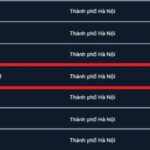The Ministry of Public Security has issued Circular 28/2024, signed by Minister Luong Tam Quang, amending and supplementing a number of articles in Circular 24/2023 on the issuance, retrieval, and registration of motor vehicle license plates.
The most notable change in this circular is the provision that allows citizens to select their license plate number through the VNeID application when registering a vehicle for the first time for domestically produced or assembled vehicles, instead of doing it in person. This regulation will come into effect from August 1, 2024.

From August 1, 2024, citizens will be able to select new vehicle license plates through the VNeID application
Specifically, Vietnamese citizens can register their vehicles for the first time using the full online public service procedure for domestically produced or assembled vehicles on the public service portal or VNeID without having to take their vehicles to the vehicle registration authority. Vehicle owners can opt to use the public postal service to receive their vehicle registration certificates and license plates.
When receiving the vehicle registration certificate and license plate, the owner shall send the vehicle’s factory inspection certificate (with the engine and chassis numbers affixed and the manufacturer’s seal affixed) to the vehicle registration authority via the public postal service.
In cases where the factory inspection certificate (with affixed engine and chassis numbers and the manufacturer’s seal) is not submitted, or where the provided engine and chassis number information does not match the declared information, the vehicle owner must bring the vehicle to the registration authority to affix the engine and chassis numbers and receive the vehicle registration results.
The VNeID public service portal will notify the assigned license plate number and provide instructions for paying the vehicle registration fee via text message, email, or notification on the VNeID application. Vehicle owners can then pay the fee through the integrated payment feature on the VNeID public service portal. After successfully paying the registration fee, the portal will notify the owner of the completed payment.
Subsequently, the vehicle registration officer will receive, check, and adjust the data of the online vehicle registration from the public service portal or VNeID, transferring it to the vehicle registration and management system (without having to physically inspect the vehicle, affix engine and chassis numbers, or take photos as per the regulations on vehicle registration procedures).
At the same time, the registration officer will print the vehicle registration form and certificate, present them to the authorized leader for approval and signature, and process the vehicle’s documents, certificate, and related records. They will also seal the vehicle’s documents, digitally sign the registration certificate, and return the registration results to the VNeID public service portal as per regulations. The vehicle registration certificate and license plate will then be delivered to the citizen via the public postal service.









































